#david wojnarowicz (silence = death)
Explore tagged Tumblr posts
Text
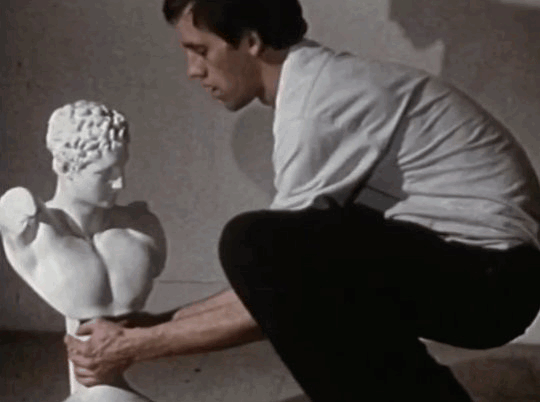
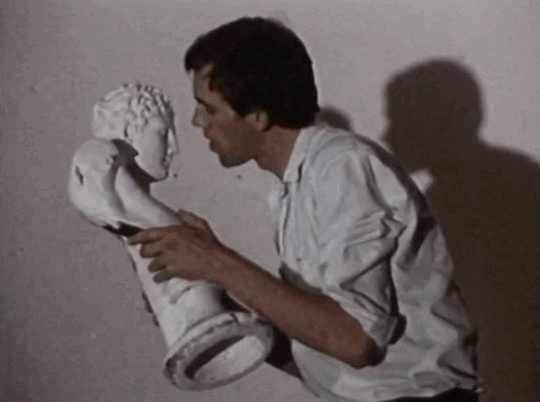
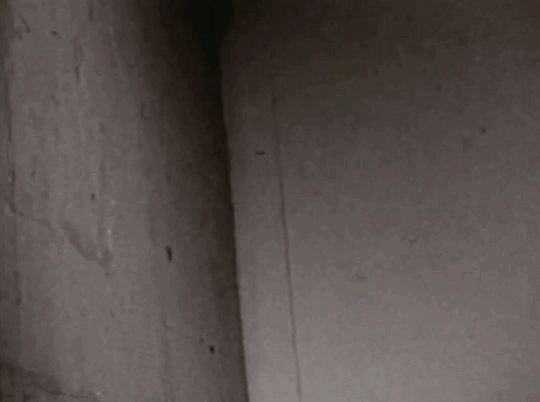

David Wojnarowicz
"Silence = Death" (1990) by Rosa Von Praunheim
106 notes
·
View notes
Text
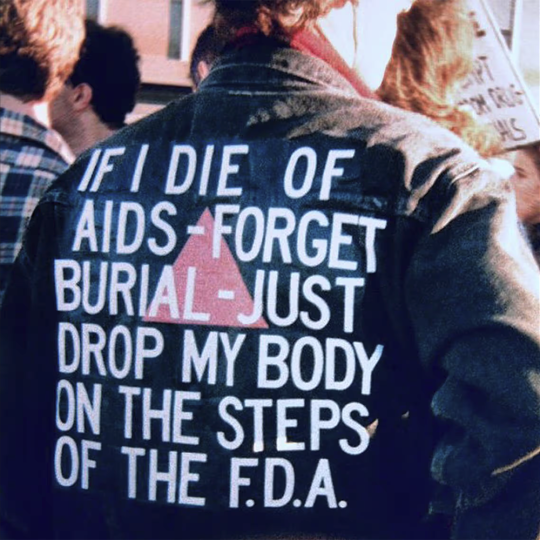
David Wojnarowicz in 1988
8 notes
·
View notes
Photo
David Wojnarowicz
David Michael Wojnarowicz; (14 de setembro de 1954 - 22 de julho de 1992) foi um pintor, fotógrafo, escritor, cineasta, artista performático, compositor/artista de gravação e ativista da AIDS americano proeminente na cena artística do East Village . Ele incorporou narrativas pessoais influenciadas por sua luta contra a AIDS, bem como seu ativismo político em sua arte até sua morte pela doença em 1992.
Biografia
Wojnarowicz nasceu em Red Bank, Nova Jersey , onde ele e seus dois irmãos e às vezes sua mãe foram abusados fisicamente por seu pai, Ed Wojnarowicz. Ed, um marinheiro mercante polonês-americano de Detroit, conheceu e se casou com Dolores McGuinness em Sydney, Austrália, em 1948, quando ele tinha 26 anos e ela 16. Após o amargo divórcio de seus pais, Wojnarowicz e seus irmãos foram sequestrados por seu pai e criados em Michigan e Long Island. Depois de encontrar sua jovem mãe australiana em uma lista telefônica de Nova York, eles se mudaram para a casa dela. Durante sua adolescência em Manhattan, Wojnarowicz trabalhou como um prostituto na Times Square. Ele se formou na High School of Music & Art em Manhattan. Em 1971, aos 17 anos, Wojnarowicz estava vivendo nas ruas em tempo integral, dormindo em casas de recuperação e ocupações.
Após um período fora de Nova York, Wojnarowicz retornou no final dos anos 1970 e emergiu como um dos membros mais proeminentes e prolíficos de uma ala de vanguarda que usava mídia mista, bem como grafite e arte de rua. Seu primeiro reconhecimento veio de estênceis de casas em chamas que apareciam nas laterais expostas dos edifícios do East Village.
Wojnarowicz completou uma série fotográfica de 1977–1979 sobre Arthur Rimbaud , fez trabalho de estêncil e colaborou com a banda 3 Teens Kill 4 , que lançou o EP independente No Motive em 1982. Ele fez filmes autônomos em super-8 , como Heroin e Beautiful People com o colega de banda Jesse Hultberg, e colaborou com os cineastas Richard Kern e Tommy Turner do Cinema of Transgression . Ele expôs seu trabalho em galerias conhecidas do East Village e marcos da cidade de Nova York, notavelmente Civilian Warfare Gallery , Ground Zero Gallery NY , Public Illumination Picture Gallery, Gracie Mansion Gallery e Hal Bromm Gallery.
Wojnarowicz também esteve ligado a outros artistas prolíficos da época, aparecendo ou colaborando em obras com Nan Goldin , Peter Hujar , Luis Frangella , Karen Finley , Kiki Smith , Richard Kern , James Romberger , Marguerite Van Cook , Ben Neill , Marion Scemama, e Phil Zwickler.
No início de 1981, Wojnarowicz conheceu o fotógrafo Peter Hujar e, após um breve período como amantes, passou a ver Hujar como seu grande amigo e mentor. Semanas após a morte de Hujar de AIDS em 26 de novembro de 1987, Wojnarowicz mudou-se para seu loft na 189 2nd Avenue. Ele logo foi diagnosticado com AIDS e, após lutar com sucesso contra o proprietário para manter o contrato de locação, viveu os últimos cinco anos de sua vida no loft de Hujar. Herdar o quarto escuro de Hujar — e suprimentos como o raro papel Portriga Rapid — foi uma bênção para o processo artístico de Wojnarowicz. Foi neste loft que ele imprimiu elementos de sua 'Sex Series' e uma edição de “Untitled (Buffalos)”.
A morte de Hujar levou Wojnarowicz a criar um ativismo e conteúdo político muito mais explícito, principalmente sobre as injustiças sociais e legais relacionadas à resposta do governo à epidemia de AIDS. Ele colaborou com o videoartista Tom Rubnitz no curta-metragem Listen to This (1992), uma crítica às respostas homofóbicas dos governos Reagan e Bush e à falha em lidar com a crise. O filme foi exibido na exposição Club 57: Film, Performance, and Art in the East Village, 1978–1983, do MoMA em 2017-18 .
Em 1985, Wojnarowicz foi incluído no chamado Graffiti Show da Bienal do Whitney . Na década de 1990, ele processou e obteve uma liminar contra Donald Wildmon e a American Family Association, alegando que o trabalho de Wojnarowicz havia sido copiado e distorcido em violação ao New York Artists' Authorship Rights Act .
As obras de Wojnarowicz incluem Sem título (One Day This Kid...) , Sem título (Buffalo) , Água , Nascimento da linguagem II , Sem título (Shark) , Sem título (Peter Hujar) , Atum , Peter Hujar Sonhando/Yukio Mishima: St. Sebastian , Delta Towels , Mito verdadeiro (Domino Sugar) , Algo do sono II , Sem título (Rosto na terra) e Sinto uma vaga náusea .
Wojnarowicz também escreveu duas memórias em sua vida, incluindo Close to the Knives: A Memoir of Disintegration , discutindo tópicos como sua infância conturbada, tornando-se um artista renomado na cidade de Nova York e seu diagnóstico de AIDS e Memories that Smell like Gasoline. Knives abre com um ensaio sobre seus anos de sem-teto: um garoto de óculos vendendo seu corpo magro para os pedófilos e pervertidos que andavam pela Times Square. O coração de Knives é o ensaio do título, que trata da doença e morte de Hujar, amante, melhor amigo e mentor de Wojnarowicz, "meu irmão, meu pai, meu elo emocional com o mundo". No ensaio final, "The Suicide of a Guy Who Once Built an Elaborate Shrine Over a Mouse Hole", Wojnarowicz investiga o suicídio de um amigo, misturando suas próprias reflexões com entrevistas com membros de seu círculo compartilhado. Em 1989, Wojnarowicz apareceu no filme amplamente aclamado de Rosa von Praunheim , Silence = Death, sobre artistas gays na cidade de Nova York lutando pelos direitos dos portadores de AIDS.
Wojnarowicz morreu em casa, em Manhattan, em 22 de julho de 1992, aos 37 anos, devido ao que seu namorado Tom Rauffenbart confirmou ser AIDS.
Após sua morte, a fotógrafa e artista Zoe Leonard , amiga de Wojnarowicz, expôs uma obra inspirada nele, Strange Fruit (para David) .

David Wojnarowicz (Silence = Death), Photo by Andreas Sterzing, 1989
871 notes
·
View notes
Text
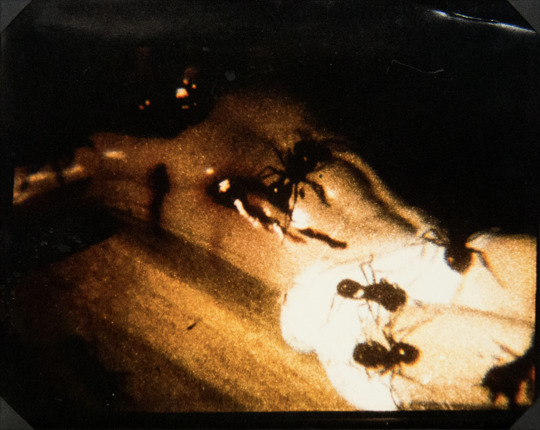
David Wojnarowicz, A FIRE IN MY BELLY (1986-1989, Super 8mm) from Rosa von Praunheim’s Silence=Death (00:04:10m excerpt, beginning at 00:49:21m). Image: Film Still: Ants on Crucifix (Color print from Kodachrome slide, 20 × 25,1 cm). This edit, done by Wojnarowicz with help from his frequent collaborator Marion Scemama, includes scenes from Mexico, etc... presented in their original order, but edited down and intercut with other footage. The first three minutes of the segment are accompanied by audio from an interview between Wojnarowicz and von Praunheim, before Diamanda Galás’s This is the Law of the Plague comes on (beginning at 00:52:18), over footage of ants crawling on a crucifix, filmed in Mexico. In The David Wojnarowicz Knowledge Base
5 notes
·
View notes
Text
David Wojnarowicz — 'Eddington' Poster
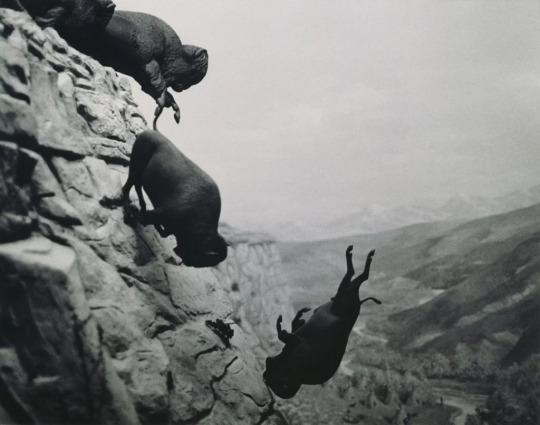
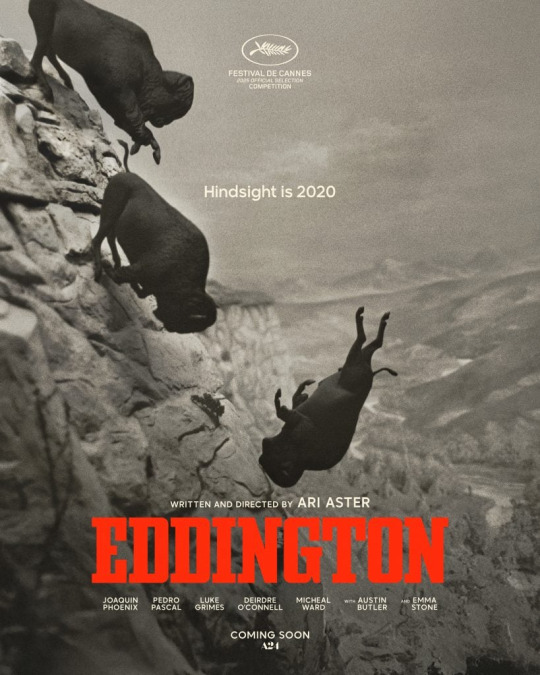
Eddington, a new film by Ari Aster (Hereditary, Midsommar), looks primed to plumb the depths of the auteur’s brand of existential and social horror.
Premiering at the Cannes Film Festival next month, the movie unfolds over the month of May 2020, as the sheriff and mayor of the titular New Mexican town clash over the most polarizing totem of the COVID-era: the face mask. What ensues, the film’s synopsis tells us, “sparks a powder keg as neighbor is pitted against neighbor.”
Another hint of the fracas in store?
The film’s poster, which depicts a trio of bison toppling down a cliffside.
Art buffs, of course, will recognize the image as a 1988–89 work by David Wojnarowicz, created amid an epidemic that reflects the movie’s portrayal of our most recent pandemic.
Untitled (Buffalos) was made following Wojnarowicz’s visit to the National Museum of American History in Washington, D.C.
There, the artist encountered a diorama of a traditional Native American hunting practice that involved driving buffalo off cliffs to their certain deaths.
The image immediately struck Wojnarowicz, who had recently been diagnosed as HIV positive after losing his partner Peter Hujar to AIDS.
In it, he recognized parallels between the cruel treatment of the animal and the U.S. government’s cold indifference to a public health and social crisis.
“It is exhausting,” he wrote in his 1990 memoir, “living in a population where people don’t speak up if what they witness doesn’t directly threaten them.”
Wojnarowicz proceeded to tightly frame a section of the diorama, rendering it in black and white, and presenting it as a stark allegory for the epidemic.
It joins his other works that also addressed the Reagan and Bush administrations’ inadequate responses to the AIDS crisis, among them the searing (Silence=Death) (1989) and Untitled (Face in Dirt) (1991).
Wojnarowicz died in 1992, aged 37.
The artist’s critiques have proved perceptive—and resonant in the light of the COVID pandemic.
When confronted by the 2020 crisis, the Trump administration similarly demonstrated rank incompetence in mounting a response and a casual disregard for the rising death toll.
The teaser for Eddington, a self-described contemporary Western, reminds us just what filled the vacuum left by that lack of a cohesive strategy.
The one-minute clip sees Eddington sheriff Joe Cross (played by Joaquin Phoenix, last seen in Aster’s Beau Is Afraid) doom-scrolling his Instagram feed.
He’s treated to a series of conspiracy theories, questionable wellness advice, and scenes of protests.
There are also hints of the discord to come, in a menacing clip of Joe stressing the fact that Eddington folk “like guns,” followed by a campaign video from mayor Ted Garcia (Pedro Pascal), promising to keep “fighting the pandemic.”
It’s a lot of noise, but surely, there will also be death.
The image in Eddington‘s poster, though, differs slightly from Wojnarowicz’s work.
The forelegs and tail of the two bison on the left have been repositioned to be more clearly defined, while the entire image has been elongated to fit poster dimensions.
It carries the objectively brilliant tagline, “Hindsight is 2020.”
A24, the production house behind Eddington, did not immediately respond to a request for comment regarding the design.
Wojnarowicz’s Untitled (Buffalos), besides its entry in museum collections and retrospectives, already boasts an indelible pop cultural presence, courtesy of U2.
In 1992, the band deployed the image, treated with a gold sheen, for the cover of its single, “One,” included in its all-conquering album Achtung Baby.
All royalties from the single are dedicated to AIDS research.
“Wojnarowicz identifies himself and ourselves with the buffalo,” the single’s liner notes read, “pushed into the unknown by forces we cannot control or even understand.”
0 notes
Photo
[Transcript of Untitled (One Day This Kid...) by David Wojnarowicz:
One day this kid will get larger. One day this kid will come to know something that causes a sensation equivalent to the separation of the earth from its axis. One day this kid will reach a point where he senses a division that isn't mathematical. One day this kid will feel something stir in his heart and throat and mouth. One day this kid will find something in his mind and body and soul that makes him hungry. One day this kid will do something that causes men who wear the uniforms of priests and rabbis, men who inhabit certain stone buildings, to call for his death. One day politicians will enact legislation against this kid. One day families will give false information to their children and each child will pass that information down generationally to their families and that information will be designed to make existence intolerable for this kid. One day this kid will begin to experience all this activity in his environment and that activity and information will compell him to commit suicide or submit to danger in hopes of being murdered or submit to silence and invisibility. Or one day this kid will talk. When he begins to talk, men who develop a fear of this kid will attempt to silence him with strangling, fists, prison, suffocation, rape, intimidation, drugging, ropes, guns, laws, menace, roving gangs, bottles, knives, religion, decapitation, and immolation by fire. Doctors will pronounce this kid curable as if his brain were a virus. This kid will lose his constitutional rights against the government's invasion of his privacy. This kid will be faced with electro-shock, drugs, and conditioning therapies in laboratories tended by psychologists and research scientists. He will be subject to loss of home, civil rights, jobs, and all conceivable freedoms. All this will begin to happen in one or two years when he discovers he desires to place his naked body on the naked body of another boy.
]
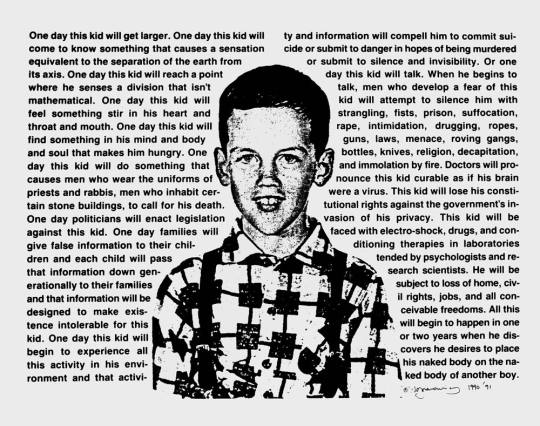
I cried the first time I read this at the MoMA.
#david wojnarowicz#i saw this for the first time online when i was 14 and was inconsolable. i came close to tears typing it up here.
9K notes
·
View notes
Text
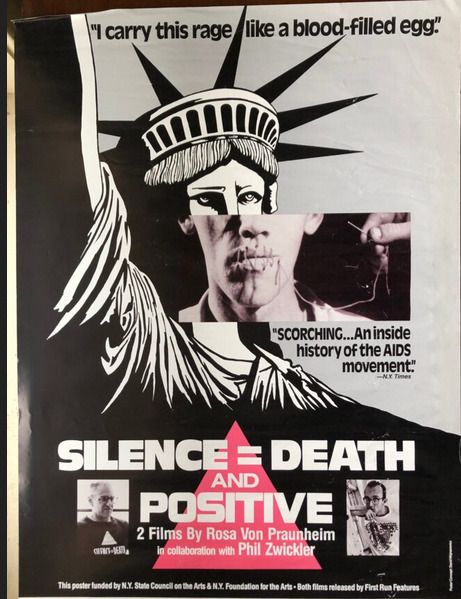
Affiche dessinée par David Wojnarowicz pour Silence = Death et Positive, deux documentaires de Rosa Von Praunheim et Phil Zwickler, 1990.
0 notes
Text
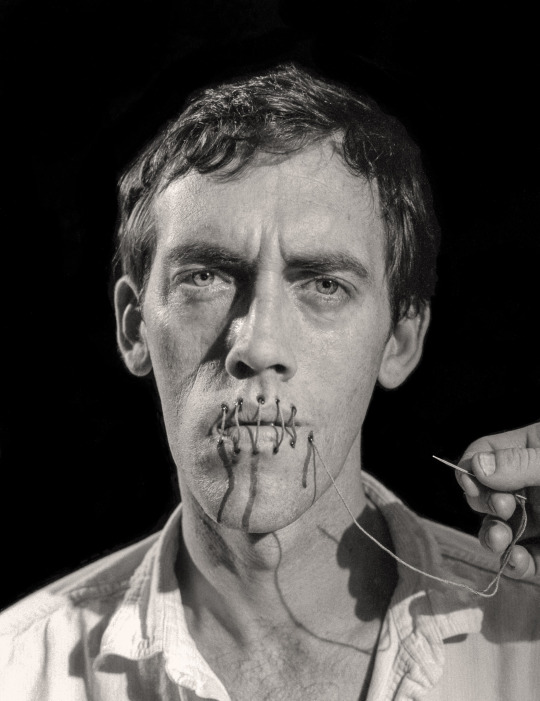
Andreas Sterzing, David Wojnarowicz (Silence = Death), 1989, New York
“I think what I really fear about death is the silencing of my voice. I feel this incredible pressure to leave something of myself behind.”
3 notes
·
View notes
Text
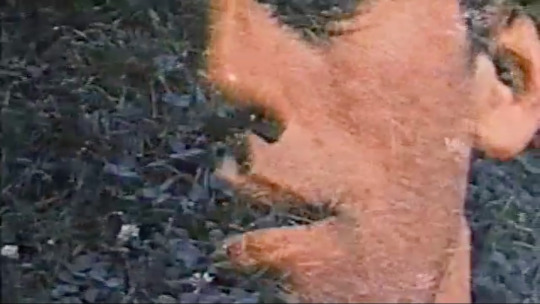
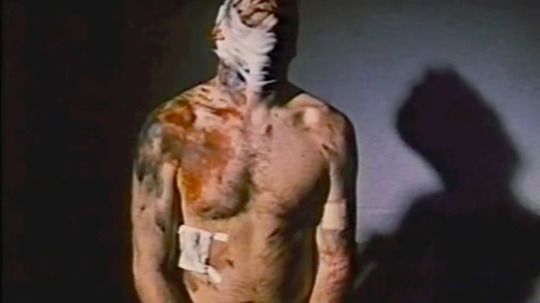
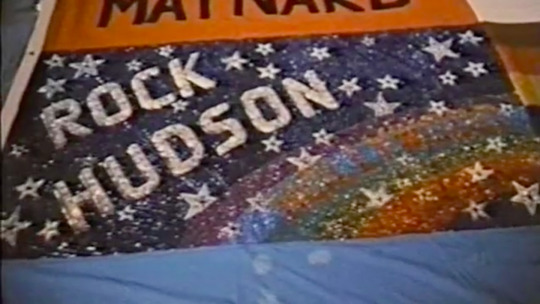
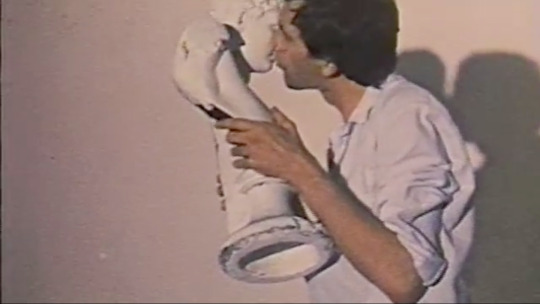
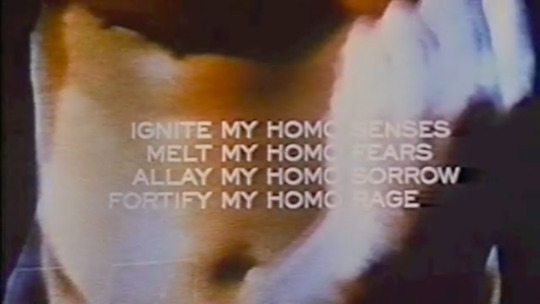
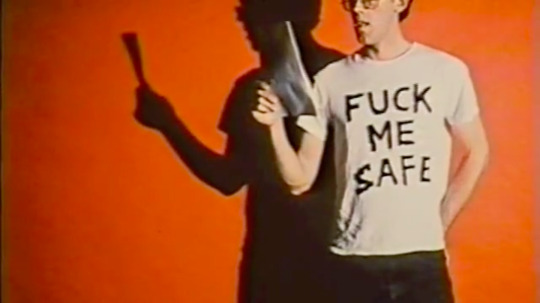
Silence = Death (1990) Dir. Rosa von Praunheim
#silence = death#silence=death#silence equals death#act up#rosa von praunheim#david wojnarowicz#keith haring#allen ginsberg#film#films#movie#movies#queer#queer history#queer cinema#lgbt history#lgbt cinema#edit#aids
1K notes
·
View notes
Text
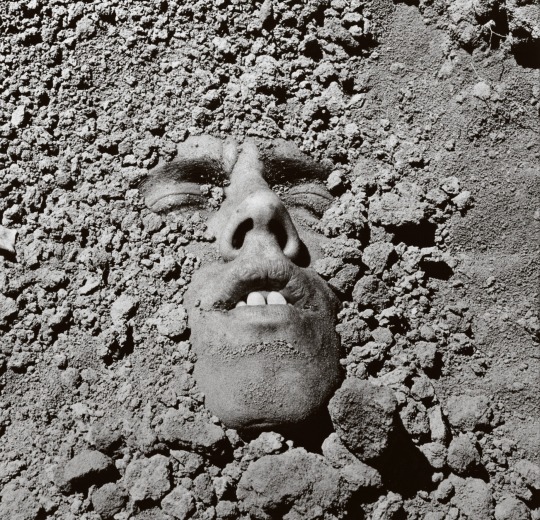
olivia laing: not long before he (david wojnarowicz) died, he made a photograph in the desert of his own face, eyes closed, teeth bared, almost buried beneath the dirt, an image of defiance in the face of extinction. if silence equals death, he taught us, then art equals language equals life.
#brb crying over david and his work and words & yes a lil drunk#need to read close to the knives asap 😭#david wojnarowicz#art
3K notes
·
View notes
Text



Art in an Emergency by Olivia Laing
on David Hockney: “Years later, he confided to a friend that he did sometimes consider suicide, adding ‘we all have a desire to survive, because we like the experience of loving.’”
on David Wojnarowicz and his art: “if silence equals death, he taught us, then art equals language equals life.”
on the work of Derek Jarman: “When he and the designer Christopher Hobbs needed a set in Caravaggio to look like Vatican marble, they painted a concrete floor black and flooded it with water, an illusion of plentitude that was somehow plentitude in its own right, because of its imaginative richness: a richness comprised not of hard cash, but of resourcefulness and effort.”
on women engaging with conceptual art in the 1970s: “As Susan Hiller remarked, ‘you have no subject matter other than what’s already in language, for my generation of women, was not what we wanted to say.’”
on the body: “There are two bodies, aren’t there? The one you see in magazines, the one that is available to strangers’ eyes, and the one you inhabit, the leaky vessel, permeable and expulsive, prone to vents and fractures; a factory, slippery and bilious, its secret compartments stained rose madder and Chinese red.”
#olivia laing#writer#female writers#feminist art#feminism#agnes martin#david wojnarowicz#Derek karma#essays#art history#research#2022reads
3 notes
·
View notes
Photo
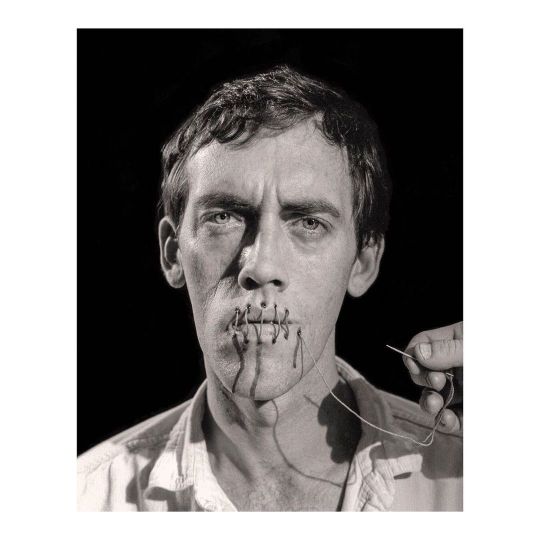
“David Wojnarowicz (Silence = Death),” Andreas Sterzing, 1989. This portrait of the artist David Wojnarowicz was made by Andreas Sterzing in 1989, a year in which AIDS was estimated by the Centers for Disease Control to be the second leading cause of death among men 25 to 44 years of age. Wojnarowicz started out as an avant-garde painter and filmmaker in Lower Manhattan, but his work became far more politically charged after he discovered, around 1987, that he was H.I.V. positive. His sewn-up mouth became a recurring image in his art and activism, a gesture that took the slogan “Silence = Death,” which had been adopted as a rallying cry by AIDS activists and serves as the picture’s subtitle, to its logical, literal extreme. The task of educating the public about the crisis was largely left to activists and artists like Wojnarowicz. “I think what I really fear about death is the silencing of my voice,” he once said. “I feel this incredible pressure to leave something of myself behind.” #WorldAIDSDay #DavidWojnarowicz #Wojnarowicz #AndreasSterzing #SilenceEqualsDeath #KnowYourStatus https://www.instagram.com/p/CW-BftRMIui/?utm_medium=tumblr
2 notes
·
View notes
Text
David Wojnarowicz (Silence = Death)

“This portrait of the artist David Wojnarowicz was made by Andreas Sterzing in 1989, a year in which AIDS was estimated by the Centers for Disease Control to be the second leading cause of death among men 25 to 44 years of age. [...]His sewn-up mouth became a recurring image in his art and activism, a gesture that took the slogan “Silence = Death,” which had been adopted as a rallying cry by AIDS activists and serves as the picture’s subtitle, to its logical, literal extreme.”
https://www.nytimes.com/2020/10/15/t-magazine/most-influential-protest-art.html
2 notes
·
View notes
Text
Notes on Pink Siifu’s NEGRO

You and anybody else who wants to get their random vicarious kicks off White Power can stay the fuck away from me.
—Lester Bangs
Tell a nazi he can suck my dick. —Pink Siifu, from “SMD”
My first contact with white america was marked by her violence, for when a white doctor pulled me from between my mother’s legs and slapped my wet ass, I, as every other negro in america, reacted to this man-inflicted pain with a cry. A cry that america has never allowed to cease; a cry that gets louder and more intense with age….A cry? Or was it a scream? —H. Rap Brown (Jamil Abdullah Al-Amin), from Die Nigger Die!
it is the hour of conflict, antagonism, struggle the world turning autumn in warpaint everything silently prepares to scream —Amiri Baraka, from “Disorder”
1.
White institutional power operates to negate or suppress. To that end, white institutional power bestows awards on singular figures when it’s convenient. Let’s call one such example Kendrick Lamar. Pulitzer Prizing DAMN. is white institutional power taking cover. This, in no way, defangs DAMN. But it does provide crowd control. Pink Siifu, meanwhile, won’t be awarded a Pulitzer for NEGRO. If he did, I’m confident he’d pull an Adrienne Rich, telling President Clinton to choke on his National Medal for the Arts, seeing as how the U.S. gov’t drives “the demonization of our young Black men.” Siifu would be PE boycotting the Grammys on the grounds of Black invisibility. Or John Lennon relinquishing his membership in the Most Excellent Order of the British Empire because, well, empire (see: Biafra).
2.
NEGRO is what happens when Three 6 Mafia goes full bandolier, full decolonization, full Thomas Sankara. When the emphasis is on the 666 sirening[1] across white cop foreheads, reflecting off Makrolon face shields. Siifu cites and channels Sun Ra, June Tyson, Death, and Bad Brains, but you also hear the mass hysteria of Abbey Lincoln’s vocal cords trembling, of Max Roach’s We Insist! in a street brawl showdown with the LRAD. Basically, it’s Ornette blowing sax in a riot, harmolodics like incendiary devices.

3.
“FK” is the primal scream reaction of hearing the news another one of your people has been killed, snuffed out. Suffer through our screams, it says to the listener. And “out of body, out of mind” distorts what we see with what we witness. It’s the re-played, re-tweeted, re-shared visuals of Black death.
4.
At moments, NEGRO sounds like Aaron Dilloway organizing a chapter of the White Panther Party.
5.
Siifu’s lyrics are a Stokely speech draft. His artistry is prismatic, shattered pane glass: crust punk, jazz cat, marching band drummer, hood ballerina, noisemaker, bareknuckle emcee. His lyrics should be run off on the mimeo and saddle-stitched into a chapbook for Totem Press to publish.
6.
“SMD” samples from Ivan Dixon's 1973 film The Spook Who Sat by the Door (“Do you hear me, man?...I am BLACK!”). Just like dead prez sampled the dialogue before Siifu on “We Want Freedom.” Siifu and dead prez are bedfellows, for sure, but Siifu's head rests on a pillow of static. It’s the friction that electrifies.
7.
NEGRO is the art of de-arresting in audio form. As the comrades at Mask Magazine have stated, de-arrests “are beautiful,” reminding us “the law and the state are not supernatural forces.”[2]
8.
I’ve always felt uncomfortable using the word freedom. It’s a word that’s been co-opted and gutted to the point of parody. I subscribe only to a different form of freedom, one articulated in noise. Suicidal Tendencies’ “Freedumb” cuts it: “Peace through politics is a fallacy—that doesn’t exist.” Liberation more seriously expresses the extinction agenda. Poor Righteous Teachers taught the curriculum out of Trenton, on “Freedom of Death”: “Consciousness—it’s a must / Just avoid the wicked, wicked ways of this pale Caucasoid.”
Regardless, we see freedom, liberation, knife through even with Siifu’s orthography. Revolutionary thought requires revolutionary language. Ask the Combahee River Collective. Come correct. Fuck autocorrect. Remember womyn. Siifu spellings like: nxggas, eye, tyme, iono, and the evergreen ameriKKKa. The abbreviated words—eliding letters wherever possible—don’t reflect self-censorship so much as the mindmaze of a harried man. Deliberate typos demonstrate no faith in the system. It’s like if Bon Iver (see: “22 (OVER S∞∞N)”) decided to forgo BLM symbolic gestures (Mahalia Jackson) and straight-up encouraged looting. Siifu is CAPS LOCK happy, too. We’re witnessing the joy of militancy.
9.
To begin with, it must be said that former African slaves and their ancestors have been the avant-garde of everything in this country. There’s no culture in America, in this American wasteland, without us. There’s no classical music; there’s jazz, and that was invented by us. And besides that, America has nothing to offer the world and it never has. —Idris Robinson, from “How It Might Should Be Done”
Siifu in the audience of the Congress of Afrikan Peoples, and Baraka imploring him like, “Get up, Pink Siifu.” It’s nation time. But on “Nation Tyme.,” Siifu groans, I’m tired…can’t fall…asleep. Black rage, of course—but what of Black insomnia? The French revolutionaries abolished the calendar. CPT, so, is rightly weaponized. “I feel fettered by Western time,” Gregory Pardlo writes in “Colored People’s Time.” Punch clocks need punching, smashing. I saw Baraka roll up to a conference panel late as fuck once, cane-walking right down the center aisle, shameless, commandingly.
In a somnolent slur, Siifu says, “They treat me like I’m wasting away / I know I’m worth more than they pay.” What of these capitalist definitions of work? What of productivity? What does it mean to monetize every waking moment? He’s been quoted as saying, “I ain’t have to work for no white man.”[3] “Nation Tyme.” picks up there.
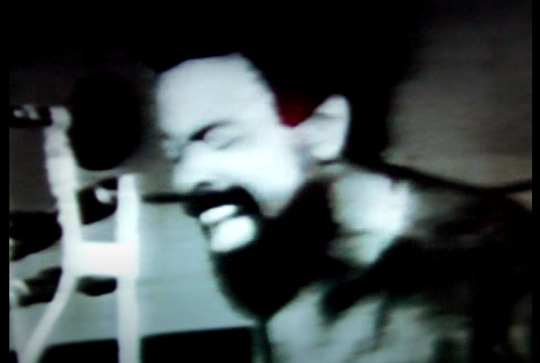
10. Feel like deadmeat. They say I’m deadmeat.
“DEADMEAT” is a pig siren stuffed into an industrial-grade slaughterhouse grinder. It sounds the way Alan Vega's sculptures look—hazardous masses of electronic junk, like wires raveled inside a homemade bomb, like buzzing viscera.
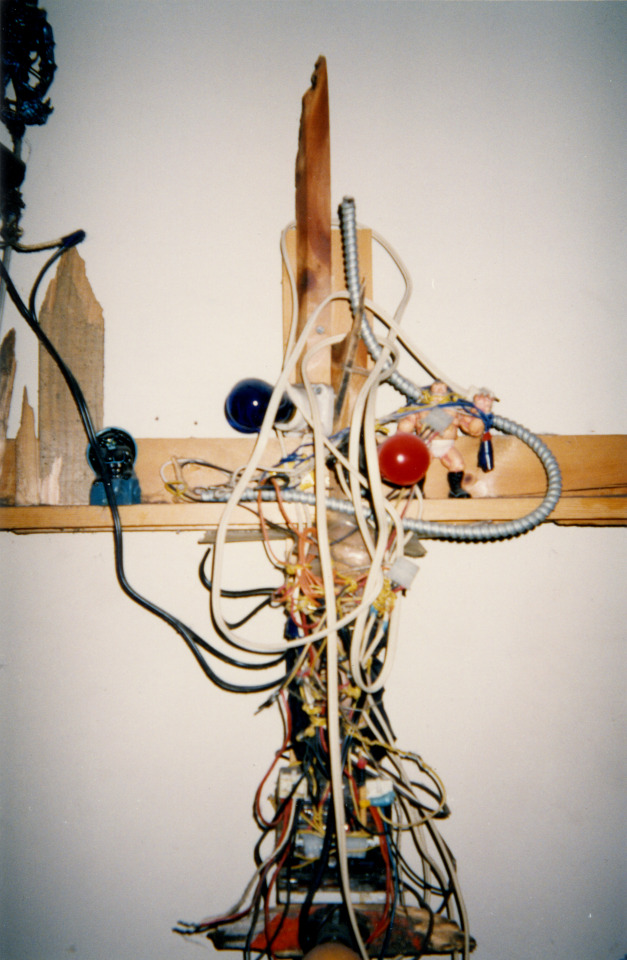
I want to see Siifu perform it at the Meat Locker, a cellar club in the underguts of Montclair, New Jersey (s/o the dramacydal Outlawz). The place is dingy and bedecked with feces—a venue befitting a GG Allin opener. GG Allin, a racist, who also hated cops. Who, on “Shove That Warrant Up Your Ass,” a track that appeared on the posthumous Brutality & Bloodshed For All album, sang, “You say I broke the laws in your state… / Your courts and cops should all be hung.” Allin hoists a headless, legless, armless torso on his hip in the cover photograph—a slab of meat. Like the Beatles with baby doll parts and prime cuts in their laps, bloodless butcher coats on the original Yesterday and Today (1966) artwork. Like the papal kill floor in Francis Bacon’s “Figure with Meat” (1954) with its tapestry of offal. But what you don’t get from Bacon, or the Beatles, or GG Allin is what Siifu needs us to hear. What Siifu tells us is the reality of corporeality is that cops continue to make carcasses of Black people.

11.
That cellar club can be scream therapy, can be cell therapy. Siifu brings us there—to the darkest, dampest corner of the Dungeon Family’s dungeon. Big Gipp, speaking self-defensively: “Try to separate me from the blood / Is disrespect like you coming in my home and not wiping your feet on the rug.” It’s echoed in Siifu addressing the question of his audience: “This [album] is for black people, but I know white people are going to fuck with it. I’m mad cool with that. I just want everyone to know, before they come through the door, that this is a black house and you have to respect my people.”[4] The theme of respect as it relates to a sense of home, to cultural tourism, is paramount in both. Everyone’s got to know their place. No listener should approach ignorant of the auction block. Siifu’s noise refuses the separation of kinsfolk and his stubbornness makes the dungeon shake—he is rightfully “tough, dark, vulnerable, moody,” and, on NEGRO, he has a “definite tendency to sound truculent.”[5]
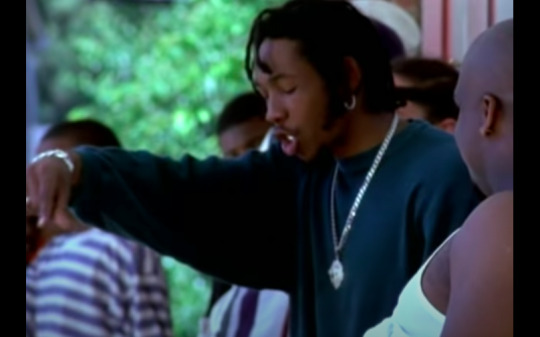

12.
“ON FIRE, PRAY!” eventually grinds the brakes to a cavernous slowjam pace. “Blood on my body / Blood on my face.”
13.
The racist dog policemen must withdraw immediately from our communities, cease their wanton murder and brutality and torture of black people, or face the wrath of the armed people. —caption on Huey Newton photograph
NEGRO’s album cover, painted by Junkyard, is a call-and-response. Pink Siifu is a portrait of exhaustion, slouched, shirtless like Huey was when he was released from the Alameda County courthouse in 1970. It’s a tableau like Huey in that rattan peacock chair was. Eldridge Cleaver orchestrated it, right down to the zebra rug.
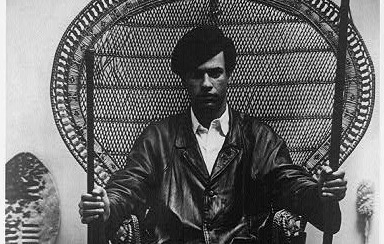
If you squint, the glimmer of Siifu’s gold fronts looks like his jaw is wired shut. Of course, violent threats are routinely directed at Black people—that's how the system operates. Media is often behind the scope. Relentless orders to “shut up,” to silence yourself, police yourself. We know this from David Wojnarowicz, photographed with his lips sewn shut, blood dripping like shadows, in “(Silence = Death)” from 1989. The violent threats on queer life are kin to those on Black life. But Siifu, like Wojnarowicz, refuses the censorship. After all, those aren't wires—they're the glint of his grill. Siifu is dribbling blood, too, and those black splatters across the flag are like pen bursts—ink poisoning for all. If you squint, the mind’s eye might see the Pan-African flag.

The flag above his head recalls Jasper Johns’ flags: elliptical, non-patriotic, made slop-bucket sloppy from newspaper shreddings and other detritus, i.e. amerikkka is a trash heap. At least the stars are black in the “Flag (Moratorium)” rendition. Bullet hole dead center, too.
If all goes well, the riots going on—bless them—will go on interminably. Sly Stone’s customized flag with black in place of blue[6] and sharp solar-flared suns in place of Betsy Ross geometric stars is yet another parallel to Siifu’s flag. Like Sly, Siifu isn’t opposed to police ambushes. They both know you’ve got to grin at the gun of the devil. (“Don’t you mind people grinnin’ in your face,” Son House sings eternally.) Citizen takes on cop on “Thank You For Talkin’ To Me, Africa”: Bullets start chasin’, / I begin to stop. / We begin to tussle. / I was on the top. Just the same as Siifu on “SMD”: “Iono why eye ain’t shot ya.” Or on “run pig run.”: “Kill a cop / Left a pig dead.”
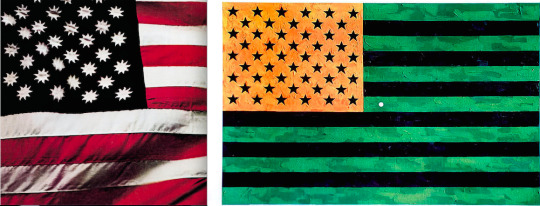
14.
We can't disparage any aggressive protest on the reductive grounds it's aggro or violent. I think of Pam Echols in Milwaukee in 1968. Siifu’s assertion of you are my enemy on “steal from the ENEMY” corresponds with Paris’s sophomore and shadowy album, Sleeping with the Enemy. Like on the corrode-ode “Coffee, Donuts, and Death”:
You get poached when you fuck with black folk. Said it ’til my voice was hoarse. I ain’t down with excessive force, But of course I wasn’t heard so I’m silent now. Black folk can’t be non-violent now. […] The only motherfucking pig that I eat is police.
Which is to say, try no pork, ameriKKKa.
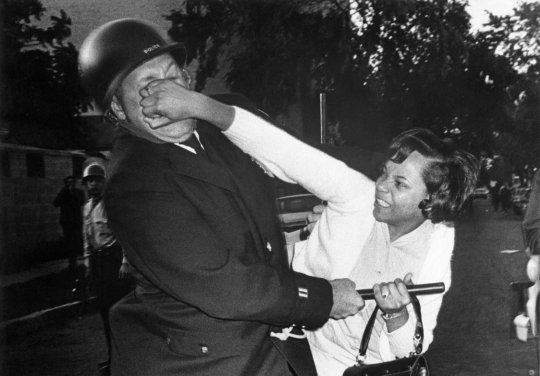
15. RE: punk
Think of Bad Brains playing CBGB’s in 1982. Lester Bangs writes of a woman in the scene who referred to Black people as “all these boons.” He tells us a Black friend of his believes the clubgoers “[strive] to be offensive however they can.” Anti-Blackness plagued CBGB’s and nascent punk like vermin, a pestilence. A white woman in the music business claims she “liked [Black people] so much better when they were just Negroes.” These anecdotes are culled from Bangs’ 1979 Village Voice piece entitled “The White Noise Supremacists.” He notes Ron Asheton’s predilection for “swastikas, Iron Crosses, and jackboots.” He cites Ivan Julian, guitarist for Richard Hell and the Voidoids—one of the few Black individuals to grace those inchoate punk stages—as saying “whenever he hears the word ‘n-----’…he wants to kill.” He calls Nico a “dumb kraut cunt” for her brazen, Third Reich-ish brand of racism, which was no industry secret. Bangs even implicates himself, quoting an earlier article: “…it’s the n-----s who control and direct everything just as it always has been and properly should be.” He meant this, somehow, as a compliment.
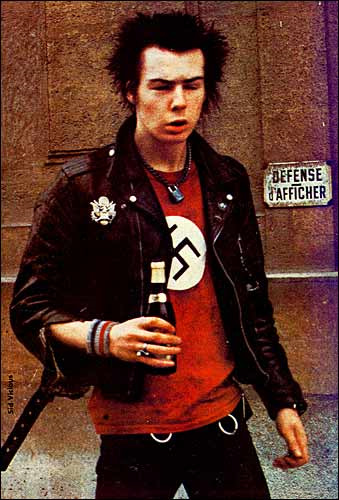
16.
On “we need mo color. Abundance,” there’s no innocence left in asking “tell me your favorite color.” Siifu answers rhetorically, parenthetically, melanin. Don't settle for forty acres of color—demand abundance. Take, loot in abundance. And don't be contained by the gendered parameters of “pink or blue.” “You can have any color you like” suggests the limitless possibilities if you move your mind beyond the imposed parameters.
The “favorite color” invoked on “we need mo color. Abundance” becomes abundantly clear on the following track, “BLACK!”
17.
“ameriKKKa, try no pork” starts in a slurry of radio static, news reports of Black death. Black, Black, Black, Black. Sped up. Slowed down. Drag the progress bar. “Progress,” ha.
18.
“run pig run.” See the pig / Run away / Run, pig, run. Like a Dick and Jane basal reader. Like picking your favorite color. Like a Three Little Pigs fable. Like huffing and puffing. These are childhood exploits for childhoods that aren’t allowed to be. As long as the Kenneth and Mamie Clark doll experiments keep providing the proof, there can be no childhood innocence. So it's a carnival game in the meantime: See a pig / Shoot a pig. Huffing and puffing: Run, pig, run.
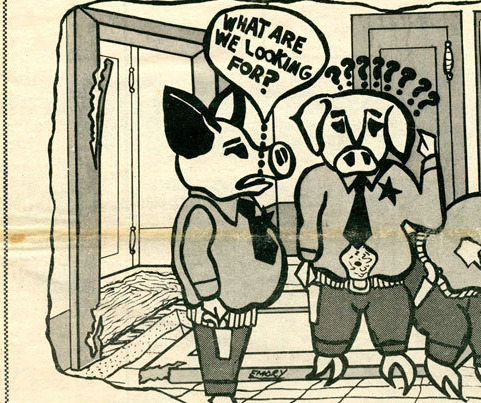
19.
"myheartHURT" is the safehouse after the shooting. It's the cooldown, the chillout. The hypnagogic nightmare. It's vaporwave minus whiteness. We all know Biz had the vapors before Daniel Lopatin. As if DJ Screw was just an apparition, a codeine cloud. The fact remains, Screw's phantasmagoria hovers above all our heads.
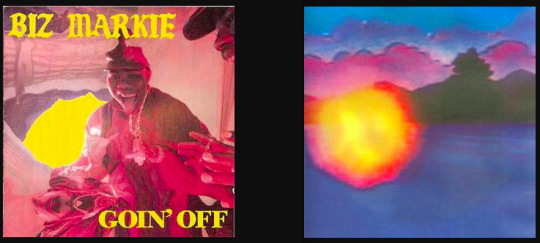
20.
The wail of distorted police sirens introduces “Chris Dorner.,” a track gleefully indebted to Ice-T and Body Count’s “Cop Killer.” Repetition was a popular device and it still is: die, pig, die. Chris Dorner has achieved folk-hero status in anarchist circles and beyond since he waged asymmetrical warfare on the LAPD. His manifesto has been published as a zine.[7] “No one grows up and wants to be a cop killer,” he wrote. Begs the question.
21.
“faceless wings,BLACK!” nods to Frank Castle[8], a figure who may or may not be recoverable from militias and thin blue liners, despite Gerry Conway’s best efforts.
22.
White institutional power operates to negate or suppress. Pink Siifu, through NEGRO, refuses suppression and negation. Siifu delivers a hole in the head, and it’s sublime.
Footnotes:
1 “The Law comes sirening across the town.” Gwendolyn Brooks, “THE THIRD SERMON OF THE WARPLAND” from RIOT
2 “De-Arrests are Beautiful.” Mask Magazine.
3 “The Necessity of Pink Siifu’s Rage.” Marcus J. Moore. The Fader.
4 “Pink Siifu’s ‘NEGRO’ is a Riotous Mix of Jazz, Rap and Punk.” Max Bell. Bandcamp Daily.
5 Baldwin, the god.
6 “What did I do to be so black and blue?” (see: Armstrong); light a reefer and listen to the phonograph (see: Ellison)
7 Research and Destroy New York City. https://researchdestroy.com/
8 https://archive.org/details/PunisherPigs
Images:
Emory Douglas work (detail), courtesy of Sean Stewart archives | Makrolon face shield, Google Image Search result | Amiri Baraka performing at the Congress of Afrikan Peoples (screenshot) | Alan Vega light sculpture (photograph) | GG Allin Brutality & Bloodshed for All album cover | The Beatles Yesterday & Today album cover | Francis Bacon, “Figure with Meat” (detail) | Goodie Mob “Cell Therapy” (screenshot) | Splitting up a family at auction, Public Domain | Huey Newton Black Panthers Minister of Defense, photographed by Blair Stapp, 1968 | Andreas Sterzing, David Wojnarowicz (Silence = Death), 1989 | Sly and the Family Stone There’s A Riot Goin’ On album cover | Jasper Johns, “Flag (Moratorium)” | Pam Echols punching cop, 1968 (photographer unknown) | Sid Vicious, nazi (photographer unknown) | Emory Douglas work (detail), courtesy of Sean Stewart archives | Biz Markie Goin’ Off album cover | Oneohtrix Point Never Memory Vague album cover
7 notes
·
View notes
Photo
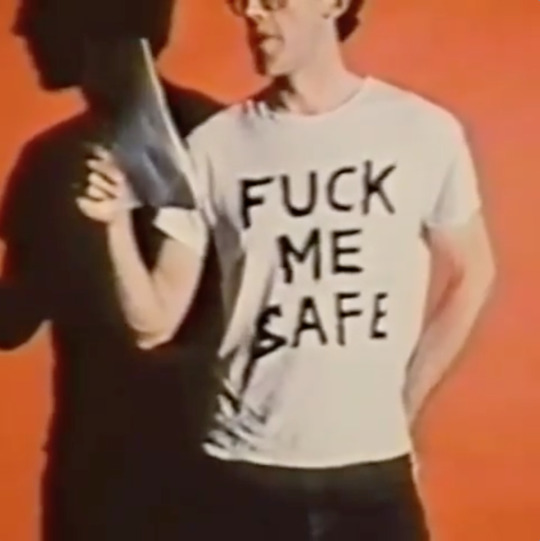
Spectacle Radio ep.56 :: 06.01.20 :: Throw Away Your Laptops, Rally in the Streets
(Born in Flames) // Mark Stewart and the Maffia - Jerusalem (Handsworth Songs) // Sam Waymon - Seduction (Ganja and Hess) // Diamanda Galas - This is the Law of the Plague (Silence = Death) // David Wojnarowicz - (Silence = Death) // Trevor Mathison (Handsworth Songs) // Society Waits for You (Society) // Red Krayola - End Titles from Born in Flames // Can - Gomorrha (The Last Days of Gomorrah) // (Song of the Shirt) // (The People's Account) // - // Brian Mcomber - Afronauts // Tony Rémy - protest montage (A Passion of Remembrance) // Carl Vine - An Island (Bedevil) // (A Different Image) // (Drylongso) // Mukul - ALGO-RHYTHM // Smarty - Le chapeau du chef (Le President) // 911 Is a Joke (Welcome II the Terrordome) // Joseph Charles - The Neighborhood Bobby (A Passion of Remembrance) // Tony Rémy - Main Titles from A Passion of Remembrance // Mark Stewart and the Maffia - Jerusalem (Handsworth Songs) (reprise) // Kimyan Law - Run Ames (Naked Reality) // (Drylongso) // J. J. Johnson - Top of the Heap // Wasis Diop - Ramatu (Hyenas) // End Titles from Welcome II the Terrordome
#Spectacle Radio#Newtown Radio#david wojnarowicz#protest#film score#soundtrack#black lives matter#mixtape
13 notes
·
View notes
